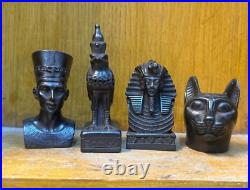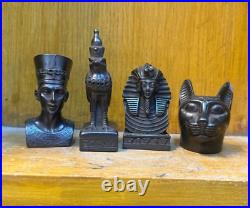


ANCIENT COLLECTION ANTIQUE STATUES Of Rare Masterpieces Egyptian Pharaohs Bc. Now own this rare Pharaonic piece, feel the ancient Pharaonic history and civilization, and decorate your home with it. A Simplified Historical Overview Of Bastet – Horus – Tutankhamun. Bastet, one of the deities of the ancient Egyptians. Worshiped in the form of a meek cat, she was merged with the deity Sekhmet in the New Kingdom, where Sekhmet was represented in the form of a predatory lioness. When Bastet gets angry, she becomes angry, and takes revenge on enemies and those who are of poor character. The city of Bubastis (Tel Basta) was the center of her cult. The cat symbolizes the deity, the deity of the sun, and was depicted in the form of an image with the head of a cat. It was accepted by Bastet, the idol of tenderness and meekness. The ancient Egyptian domesticated the cat, noting that it hunted mice that entered the granaries, eating them and spoiling them. The ancient Egyptian also raised them in homes. It was found in Egypt on one of the large tombs containing about a million mummified cats, mummification very accurate and provisions. It shows great respect for her. She was represented as a fertility deity in the form of a cat or in the form of a woman with the head of a lioness. She represented fertility, love, tenderness, and the protector of a pregnant woman. Sekhmet on the wall of the Temple of Kom Ombo in Egypt. They represented joy, dance, music, and feasts, and they also had a hint of meekness like anger and predation. Historical History of Bastet, Late Antiquity, a lioness, who represents the predatory territory of Bastet when she is angry. The cult of Bastet prevailed in the city of “Bubastis” (in Lower Egypt), and it was considered the mother of Aboud al-Assad Mahas. She was also considered in Heliopolis as the daughter of Atum. According to other texts, she is considered as the daughter of the deity “Nefertum”. They may in some cases be compensated for the situation. In the era of the ancient Egyptian kingdom, Bastet was considered the deity of Hathor (Hatour), and the deity Sekhmet was worshiped in Memphis. In the Middle Dynasty, the gods were represented as death. Horus In Ancient Egyptian, is one of the most significant ancient Egyptian deities who served many functions, most notably as god of kingship and the sky. He was worshipped from at least the late prehistoric Egypt until the Ptolemaic Kingdom and Roman Egypt. Different forms of Horus are recorded in history, and these are treated as distinct gods by Egyptologists. These various forms may be different manifestations of the same multi-layered deity in which certain attributes or syncretic relationships are emphasized, not necessarily in opposition but complementary to one another, consistent with how the Ancient Egyptians viewed the multiple facets of reality. He was most often depicted as a falcon, most likely a lanner falcon or peregrine falcon, or as a man with a falcon head. The earliest recorded form of Horus is the tutelary deity of Nekhen in Upper Egypt, who is the first known national god, specifically related to the ruling pharaoh who in time came to be regarded as a manifestation of Horus in life and Osiris in death. The most commonly encountered family relationship describes Horus as the son of Isis and Osiris, and he plays a key role in the Osiris myth as Osiris’s heir and the rival to Set, the murderer and brother of Osiris. In another tradition, Hathor is regarded as his mother and sometimes as his wife. Tutankhamun is one of the pharaohs of the eighteenth Egyptian family in the history of ancient Egypt, and he was the pharaoh of Egypt from 1334 BC to 1325 BC. Tutankhamun died young and was buried in his tomb in the Valley of the Kings. Tutankhamun was nine years old when he became Pharaoh of Egypt, and his name in the ancient Egyptian language means “the living image of the god Amun”, the chief of the ancient Egyptian gods. Tutankhamun lived in a transitional period in the history of ancient Egypt, where he came after Akhenaten , who tried to unite the gods of ancient Egypt in the form of the One God. During his reign, a return to the worship of the multiple gods of ancient Egypt took place. His tomb was discovered in 1922 in the Valley of the Kings by British archaeologist Howard Carter. This discovery caused a widespread media stir in the world. As Shown In Pictures. Type : Bastet – Horus – Tutankhamun Statues. Color : As Shown In Pictures. Our Guarantee?? : That the Item Will Delivered to You As Shown in Pictures Therefore we recommend that you see the picture well and then take your decision and take your responsibility. In any case, if you are not satisfied with the product, first, please contact me and I will do everything to your?? satisfaction.

